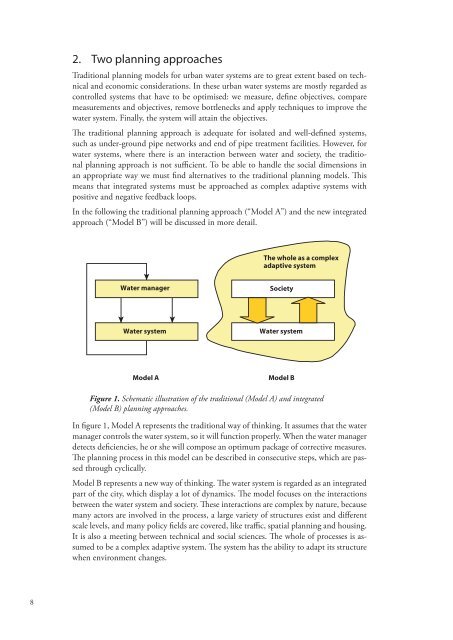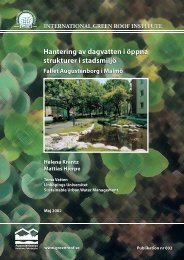New Approach to Sustainable Stormwater Planning - Visit WordPress
New Approach to Sustainable Stormwater Planning - Visit WordPress
New Approach to Sustainable Stormwater Planning - Visit WordPress
Create successful ePaper yourself
Turn your PDF publications into a flip-book with our unique Google optimized e-Paper software.
8<br />
2. Two planning approaches<br />
Traditional planning models for urban water systems are <strong>to</strong> great extent based on technical<br />
and economic considerations. In these urban water systems are mostly regarded as<br />
controlled systems that have <strong>to</strong> be optimised: we measure, define objectives, compare<br />
measurements and objectives, remove bottlenecks and apply techniques <strong>to</strong> improve the<br />
water system. Finally, the system will attain the objectives.<br />
The traditional planning approach is adequate for isolated and well-defined systems,<br />
such as under-ground pipe networks and end of pipe treatment facilities. However, for<br />
water systems, where there is an interaction between water and society, the traditional<br />
planning approach is not sufficient. To be able <strong>to</strong> handle the social dimensions in<br />
an appropriate way we must find alternatives <strong>to</strong> the traditional planning models. This<br />
means that integrated systems must be approached as complex adaptive systems with<br />
positive and negative feedback loops.<br />
In the following the traditional planning approach (“Model A”) and the new integrated<br />
approach (“Model B”) will be discussed in more detail.<br />
Water manager<br />
Water system<br />
The whole as a complex<br />
adaptive system<br />
Society<br />
Water system<br />
Model A Model B<br />
Figure 1. Schematic illustration of the traditional (Model A) and integrated<br />
(Model B) planning approaches.<br />
In figure 1, Model A represents the traditional way of thinking. It assumes that the water<br />
manager controls the water system, so it will function properly. When the water manager<br />
detects deficiencies, he or she will compose an optimum package of corrective measures.<br />
The planning process in this model can be described in consecutive steps, which are passed<br />
through cyclically.<br />
Model B represents a new way of thinking. The water system is regarded as an integrated<br />
part of the city, which display a lot of dynamics. The model focuses on the interactions<br />
between the water system and society. These interactions are complex by nature, because<br />
many ac<strong>to</strong>rs are involved in the process, a large variety of structures exist and different<br />
scale levels, and many policy fields are covered, like traffic, spatial planning and housing.<br />
It is also a meeting between technical and social sciences. The whole of processes is assumed<br />
<strong>to</strong> be a complex adaptive system. The system has the ability <strong>to</strong> adapt its structure<br />
when environment changes.



